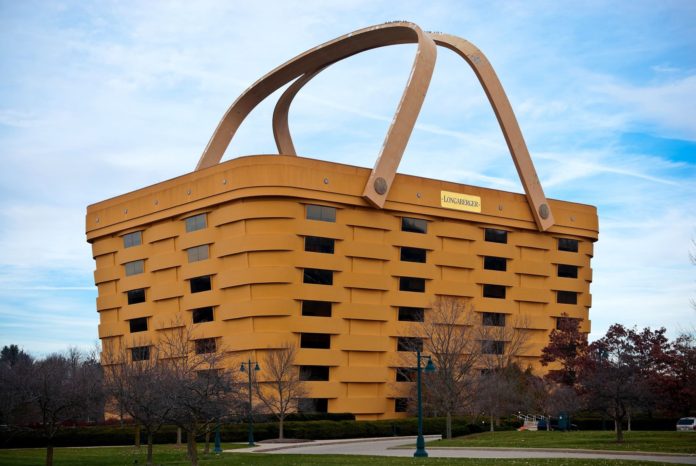“You might see it three or four miles off before you come around the bend, and then you say, ‘That is a basket. That is unquestionably a basket,'” said Tom Rochon.
It is a basket, or rather, a seven-story office building shaped like one-a massive facsimile of the signature picnic basket made by the company once headquartered there. Some 40 miles outside Columbus, Ohio, the basket building, as it’s locally known, is one of the area’s grandest attractions, inviting quirky selfie-seekers, architecture nerds, and, of course, basket enthusiasts.
Despite its celebrity, its owner has had trouble off-loading the gargantuan basket, due to its size, location, and-well, you’ve seen it, right?
When the property-slightly larger than another Ohio landmark, Cleveland’s Rock and Roll Hall of Fame-was listed 18 months ago, the asking price was $7.5 million. Now it’s on the market for $5 million, or about $28 a square foot, about half of what traditionally shaped office buildings in the area usually sell for, according to Columbus real estate adviser Bradford L. Kitchen, president of the real estate advisory firm Alterra. The basket building’s listing agent, Michael Guagenti of Cushman & Wakefield, said commercial property in the area typically ranges from $50 to $80 a square foot.
The basket was built for about $32 million and finished in 1997, according to Guagenti, as a home for the Longaberger Company. Known for its kitschy baskets, both decorative and functional, Longaberger has been around since the 1970s and once boasted sales of $1 billion, largely the result of direct-sales agents who hawked baskets at Tupperware-esque parties.
But its sales reportedly fell to $100 million in 2012. As Longaberger moved workers from the basket building to a nearby factory, its Dallas-based holding company, JRJR Networks, for which Rochon works, decided to sell to “consolidate and streamline our operations,” Chief Financial Officer Chris Brooks said in a June earnings statement.
Guagenti admitted it’s the most unusual property he’s tried to sell. “It’s a very challenging building,” he said. “We have had a couple [offers] but nothing that materialized.” Thus far, only developers have shown interest, though Guagenti declined to specify the number or size of the bids.
At 180,000 square feet, the basket is one of the largest buildings for miles around. Guagenti has reached out to local businesses in an effort to convince them to move, playing up the basket’s discounted price, but the space is too large for most. “Just no one is big enough to take that kind of basket on.”
And it’s not without other flaws. Paint has trouble adhering to its massive handles, which are heated to prevent snow buildup, and as a result they look chipped, said Rochon. The entire basket could use a paint job, Guagenti agreed, though he said the interior is pristine and modern. “There’s nothing baskety inside,” he said. “Nothing makes you feel like it’s in a basket. You feel like you’re in a nice, high-rise office building.”
But while paint can be reapplied, the building can’t be moved.
“It’s like they say: location, location, location. It has two things against it: It’s a far location, and it’s a unique building. The location is probably what’s worse,” said New York-based real estate broker and author Brendon DeSimone.
Local real estate adviser Kitchen agreed: “It takes a special buyer that is willing to go to that location. It’s a little bit too remote, as it’s just outside Columbus. It’s pretty far out for a Columbus company to think of moving there.” If the building were closer to town, Guagenti thinks he would have sold it by now.
That has meant rethinking how the building could be used. To lure a buyer, Guagenti has explored marketing it as ripe for being repurposed as an educational facility, nursing home, or call center-though he also thinks it would do just fine remaining an office building. Experts agree it might fare best as a hotel or convention center, using the building’s aesthetic to attract tourists. Although the area has a population of only about 47,000, Rochon said tour groups do occasionally make pit stops at the basket.
As for the fundamental basket-ness of it, it’s not clear how much can be done. Refacing the building isn’t much of an option, Guagenti said, because much like a basket, it’s narrower on the bottom and wider on top, which would look strange even without the woven exterior.
“But you could take the handles off,” he reasoned. “I’m sure a good architect could come up with some paint scheme to make it look not like a basket.”






